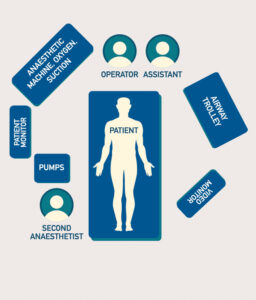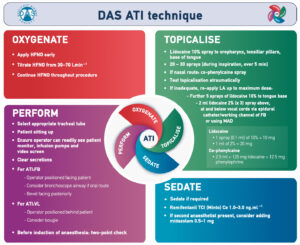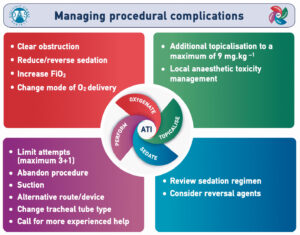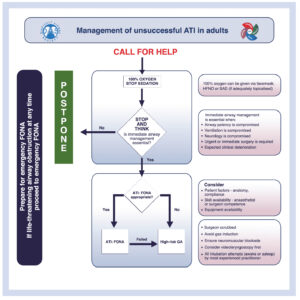The Difficult Airway Society (DAS) has recently published new guidelines for awake tracheal intubation (ATI) in adults. When performed correctly, ATI has a favorable safety profile for patients with an anticipated difficult airway. The guidelines cover the indications for ATI, appropriate room setup, checklists, appropriate oxygenation, airway topicalisation, sedation guidelines, two step tracheal tube position assessment, potential complications and options for managing an unsuccessful ATI. The primary recommendations for ATI are:
- ATI should be considered in any patient with a potentially difficult airway
- Mallampati class IV airway
- Morbid obesity
- Obstructive sleep apnea
- Short, thick neck
- Short thyromental distance
- Short chin length
- Poor jaw opening
- Limited neck extension
- Patient’s with head/neck pathology
- A checklist is recommended for ATI
- Administer humidified, high flow nasal oxygen
- Adequate airway topicalisation of posterolateral oropharynx and base of tongue
- Maximum lidocaine is 9 mg/kg based on lean weight
- 1 mL 4% lidocaine = 40 mg
- 1 spray 10% lidocaine = 10 mg
- Monitoring
- Continuous ECG monitoring
- Continuous oximetry
- Continuous EtCO2 monitoring
- BP monitoring every 5 minutes
- Cautious use of mild sedation
- Remifentanyl
- Midazolam
- Dexmedetomidine
- Low-dose ketamine
- Limit the number of attempts to three
- Administer full ventilator sedation and analgesia only after a two-point check
- Visual confirmation of tube through vocal cords for video laryngoscopy OR visualization of tracheal mucosa for fiberoptic bronchoscopy
- Capnography
Room Setup
- Operator at head of bed
- Patient in semi-upright or reverse Trendelenberg position
- Operator has view of patient monitor and video monitor
- Mark where the cricothyroid membrane is and have a cricothyroidotomy kit immediately available
- Airway cart is immediately available
ATI Technique
- Oxygenate with heated, humidified high flow nasal oxygen system
- Dry secretions using glycopyrrolate 0.2-0.4 mg IV at least 5 minutes before airway topicalisation
- Have bougie immediately available
- Can perform ATI using either fiberoptic bronchoscope or videolaryngoscopy
- Adequate topicalisation is essential
- Use 20-30 sprays 4-10% lidocaine in atomizer and spray posterior pharynx, base of tongue and lateral recesses around tonsils
- Test using oropharyngeal airway to assure gag reflex has been abolished
- Under direct visualization, spray 3 mL 4% lidocaine using mucosal atomizing device onto vocal cords
- Mild sedation options
- Remifentanil 0.75 mcg/kg infused over 5 minutes
- Dexmedetomidine 1 mcg/kg infused over 10 minutes
- Midazolam 0.5-1 mg IVP
- Ketamine 0.5 mg/kg IVP
Managing Complications
- Suction +/- glycopyrrolate to clear secretions
- Consider reversal of opiates and benzodiazepines
- Change to smaller endotracheal tube size
- Call for help
- LIMIT NUMBER OF ATTEMPTS
Options for Failed ATI
- If immediate airway management is needed:
- Call for HELP
- Assess if patient should undergo a front of neck airway (FONA) and if so perform a FONA
- If FONA not appropriate or if FONA has failed options include neuromuscular blockade then:
- Supraglottic airway (King tube or LMA)
- Video laryngoscopy intubation
- Bougie-assisted intubation

Source: Ahmad I et al. Difficult Airway Society guidelines for awake tracheal
intubation (ATI) in adults. Anaesthesia. 2019 Nov 14. doi: 10.1111/anae.14904.




